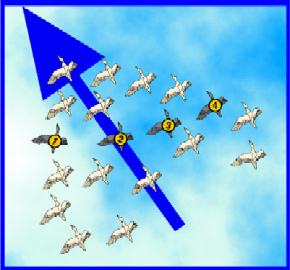

Many groups of animals display behavior that suggests some sort of coordination among or centralized control over individuals. However, no centralized method of control seems possible, since most animals do not seem to utilize the sorts of communication necessary. Rather, the complex group movements of flocks and herds seem to be the result of the actions and reactions of each individual member of the group. Each member simply acts based on what information it can readily obtain, and the aggregate is a fluidly moving union of creatures.
Boids are modeled using a modified form of particle systems modeling, in which each boid is a particle that has several different properties, such as velocity, orientation, and location. Each boid senses the world around it, including the behavior of its fellow boids, and reacts to its sense data based on three simple rules that attempt to codify natural animal behavior:
Animals have many reasons for joining together in groups. The first rule prevents accidents between boids, since no animal traveling in a group wants to collide with the other animals in that group. The second rule allows the boids to maintain similar speeds to their neighbors, and the third keeps each boid at a comfortable distance from the rest. Since each boid only knows what is going on around it, the second and third rules guide a boid's behavior based on its immediate neighbors' behavior. The flock centering rule allows the boids to split around obstacles without problems.
The combination of these three rules produces individual boid behavior that nicely models real-life animal behavior. Boids, even if initially placed at random in their environment, quickly join together in groups, and they maintain the structures of these groups without any direct form of communication. In short, boid model implementations of flocks, swarms, and herds realistically simulate how groups of animals act in many different situations.
Some boid models use additional rules, such as this one, which introduces a rule that impels the boids to maintain a clear view in front of them, and this one, which introduces an obstacle avoidance rule in addition to the first rule. (Interestingly, the addition of the clear view maintainance rule results in flock formations that are very V-shaped.)
home
boid models
applications
bibliography
last updated: May 5, 2000 (chris boone,
sam hillier)